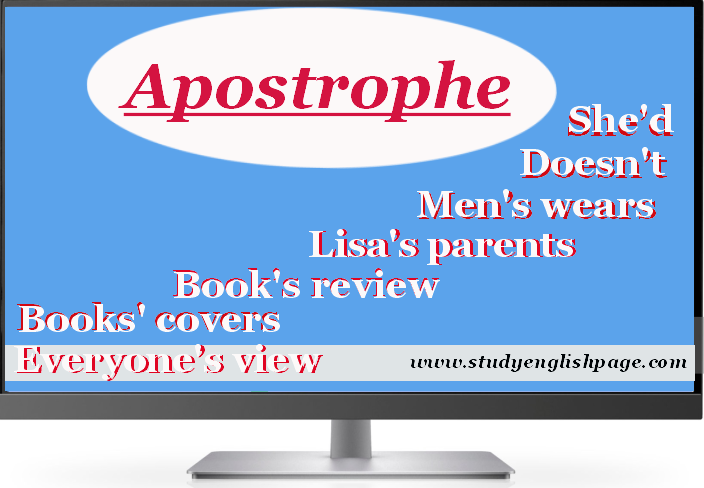Apostrophe
The apostrophe is a punctuation mark that we use to transfer a word into contraction, plural, or possessive form.
The apostrophes has great importance in the English language. They are tricky, but they avoid confusion. We are going to study everything regarding an apostrophe in this article.
Apostrophe with Contraction
A contraction is a shortened
form where we have missing letters or sounds. We use an apostrophe to represent
the missing letters or sounds. The apostrophe is replaced with the missing
letters or sounds.
Examples of Apostrophe with Contractions
|
Not |
Does not, is not, has not, had not, was not,
will not, cannot |
Doesn’t, isn’t, hasn’t, hadn’t, wasn’t, won’t,
can’t |
|
Is/are/am |
He is, they are, I am |
He’s, they’re, I’m |
|
Has/have/had |
He has, you have, he had |
He’s, you’ve, he’d |
|
Will/would |
I will, she will, I would |
I’ll, she’ll, I’d |
|
Wh-question words |
Who is, what have, where is/has |
Who’s, what’ve, where’s |
Some writers use certain words
in shortened form with an apostrophe to show that the original word is
shortened.
- Influenza = ’flue
- 1990 = ’90
Sometimes, an apostrophe is
used to show missing sounds in pronunciation.
- Somethin’ = something
- E’eer = ever (in poetry)
- Y’all = you all
In formal writing, it is
suggested to avoid using contractions.
Possessive Apostrophe
We can use an apostrophe to
form possessive nouns.
Apostrophe with Singular and Indefinite Pronouns
Singular nouns and indefinite
pronouns need apostrophes + s to make their possessive form.
- John’s notebook
- Teacher’s guidelines
- Everyone’s view
When there is a singular proper
noun that ends in “s”, you have two options. One option is to add an apostrophe
+ s, and the other is to add just an apostrophe.
- Dickens’ novels
- Dickens’s novels
Plural Possessive Apostrophe
How to make possessive of a plural
noun? Look at the noun whether it ends in “s” or not. If a noun ends in “s”, add only an apostrophe. In case of irregular nouns,
add an apostrophe + s.
Students’ books
- Teachers’ rights
- Men’s wears
- Children’s choices
Join Possessive and Apostrophe
When we talk about things that
belong to more than one person, their possessive forms can be made in two
different ways. When one thing belongs to many people, we add an apostrophe + s
to the final name.
- Bob and Lisa’s parents
When we have different things
that belong to different people, we make the possessive form of all the names.
- Anna’s, Bob’s, and John’s parents
Apostrophe to Make Plurals
Apostrophe with Lowercase Letters and Single Digits
The plural form of lowercase
letters is just adding an apostrophe + s.
- Capitalize all i’s.
- There are 2 n’s and 2 a’s in Anna.
The same rule is applied to
single digits.
- There are three 5’s in 555.
Apostrophe with Capitalized Letters
When we talk about capitalized
letters, many writers suggest an apostrophe after a single capital letter.
- I have written A’s for those who were absent.
An apostrophe is not
necessarily used with more than one capitalized letter.
- ABCs
- MPs
- M.D.s
Apostrophe with Abbreviations
Abbreviations don’t need
apostrophes to make their plural. It should be in your mind that you can use
apostrophe + s with awkward abbreviations. An awkward abbreviation ends with "s".
- MOTs (Ministry of Transport)
- SUSs or SUS’s (Soldier Under Sentence)
Note: An apostrophe is a
correct option with lowercase abbreviations and a mixture of uppercase and
lowercase letters.
- PhD’s
- kb’s
Apostrophe with Decades
Years and decades can be
written differently like
- The 1980s
- The 1980’s
- The ’80s
- The 80’s
Apostrophe for Clarity
To make the plural of a word
that is not a number, some writers use an apostrophe just for clarity.
- Do’s
- If’s
- But’s

